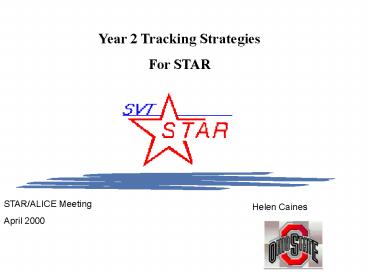Year 2 Tracking Strategies PowerPoint PPT Presentation
Title: Year 2 Tracking Strategies
1
Year 2 Tracking Strategies For STAR
STAR/ALICE Meeting April 2000
Helen Caines
2
STAR in Year 2
TPC Inner radius 50cm Outer radius
200cm h ?1.7 SSD layer radius
25cm h ?1 SVT 1st layer
radius 6cm 2nd layer radius10cm 3rd layer
radius 15cm h ?1
RICH
SVT
Near 4p acceptance multi-signature Event-by-Event
analysis
3
SVT - Details
The SVT A wafer is 6.2 cm x 6.2 cm area, 300
micron thick - 0.3X0 Average radiation length
seen by a particle if 4.5X0 incl. fee cards
etc. Consists of 216 wafers 3 barrels Inner
barrel has 8 ladders 4 wafers/ladder
Middle barrel has 12 ladders 6
wafers/ladder Outer barrel has 16 ladders
7 wafers/ladder Resolution 20 microns
Outer radius 15cm Middle Radius 10cm Inner
radius - 6cm Length - ?21cm
4
SSD Details
The SSD Double sided silicon strip detectors 16
wafers per ladder Stereo angle 35 mrad pitch 95
microns. Detector size is 7.5cm x 4.2xm 300
microns thick. Resolution is 15 microns in r
700 microns in z radiation length of 1 ladder is
0.7X0
5
Integrated Tracking Methods with the Year 2
detectors
- Two methods
- Track-Track matching between TPC and vertex
detectors - Form tracks independently in the SVTSSD and
the TPC. - Then project all tracks to a given radius and
match vectors - Track-Space point matching between TPC and vertex
detectors - Project the TPC to individual barrels and
match the closest space-point within given
constraints.
6
SVT-SSD Stand-Alone Tracking Algorithms
Grouping Technique (finder only) If one assumes
straight lines for the tracks instead of helices
a trivial mapping in f-j from the primary vertex
places all hits on a track into the same
location. For a particle with pt 100MeV/c in a
0.5T field f(R15cm) -f(R5cm) 5.10 So we
need bins of close to 50 so most tracks have all
their space points within a f bin If you iterate
increasing the binning for hits you move to
lower and lower pt (or larger radii of
curvature). Advantagethis method is fast.
7
Tracking via grouping
For primaries this technique has been shown to be
over 94 efficient, and for pt gt200MeV/c the
efficiency 97 when using the SVT alone.
8
Tracking with the Year 2 Method 1
- Disadvantage of the grouping technique is you can
only find primaries, or tracks appearing to
originate from the primary vertex. - So we have a standard follow your nose tracker
which tries to identify secondary tracks and
those tracks with too low a pt to be successfully
identified by the grouping technique. - It starts at the primary vertex.
- Takes a point on the first barrel
- Using straight line projections it projects to
the second barrel, finds closest hit within a
search cones - Projects to next barrel, finds closest hit etc to
4th barrel - All 3 hit candidates for that hit are identified.
A helix fit is done for each track. Best fit is
selected as the track - Hits are removed from pool and iteration starts
with next hit
9
Tracking with the Year 2 detectors
Primaries
Secondaries
0
1 GeV
1GeV
0
10
Tracking Matching between Vertex detectors and TPC
We then take all tracks from SVTSSD and tracks
from TPC. Project tracks to a common radius. Form
a footprint of each track at that radius, size of
footprint dependant on errors from track fit and
a gross estimate of the material the track as
passed through. Match best pairs of tracks. We
take advantage of the this step and have VERY
loose cuts in the SVTSSD tracking. This means we
pass many fake tracks to the matcher. The matcher
then weeds these bad tracks out. i.e the SVT
tracking tries to get a high efficiency at the
expense of purity.
11
Tracking with the Year 2 Method 1
Track-Track matching SVTSSDTPC Primary Fin
dable 1743 Correct 1366 - 78 Ghost 158
- 10
Secondary Findable 252 Correct 71 -
28 Ghost 31 - 30
12
(No Transcript)
13
Space Point Track Matching
Takes 5 passes At least 1 hit in each layer At
least one hit in each layer with larger search
cone At least one is in 3 different layers At
least one hit in 2 different layers At least one
hit in the SSD In each pass there are 7
iterations over pt thresholds (high pt
first) Project to SSD, find hit, refit track,
mover to next barrel
14
Track-Hit Matching Efficiency
0
1.5
-1
1
15
Tracking with the Year 2 detectors Method 2
Secondary Findable 252 Correct 71 -
28 Ghost 31 - 30
Track-Space point matching Note there are now
more findable hits as allow as few as 1 hit per
track Primary Findable 1778 (1743) Correct
1399 (1366) - 78 Ghost 263 (158)
- 16
Secondary Findable 333 (252) Correct 202 (71)
- 61 Ghost 90 (31) - 31
16
Upgrades/ Future work
Speed!!!! Integrate space point to track
matching with grouper technique Take out the
easy to find high mtm tracks using a fast method
then apply track-hit matching The improvement of
the secondary reconstruction is counterbalanced
by the increase in ghost contamination Integrate
dE/dx into the hit matching from SVT and SSD Take
into account the material passed through by the
track. Take advantage of kalman /propagation
(Geane/other?) work being done for year 1.

